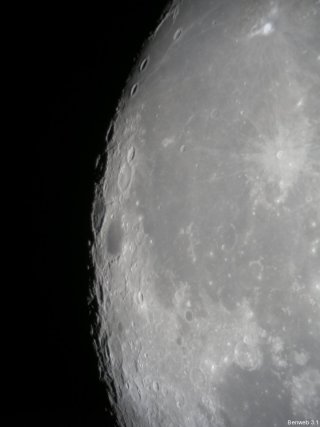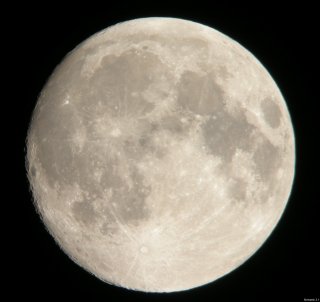The thirteen-day-old moon shows us the giant crater Schickard at a slightly less dramatic angle of illumination than on day twelve; the terminator has moved on, so the crater no longer has the contrast that it displayed a day earlier. In general, the play of light and shadow at the terminator line is what gives features on the moon their visual interest. You can see this illustrated dramatically in Harold Hill’s Portfolio of Lunar Drawings, which includes many different views of individual craters; in some of them the only difference is the angle of the light, but the effects are quite striking. Just about the only thing that’s different in most of these studies is that the moon itself is oriented differently from drawing to drawing due to libration effects. And so the crater displays subtle differences in appearance, with spots of light appearing or refusing to appear, etc.
There are, of course, exceptions, to the “low angle of illumination looks best” rule; the most notable are the famous ray craters Copernicus, Kepler, Tycho, and Proclus, which come into prominence some days after the sun has risen over them. But in those cases what is interesting about them isn’t so much the craters themselves (although they all are fascinatingly complex when viewed near sunrise or sunset); it’s the ray systems that emanate from them.
An interesting area near tonight’s terminator line is the area around the large crater, Grimaldi, located just about on the moon’s equator. This crater looks almost like one of the maria, it’s so dark and the rim is so eroded. To its upper left is the more craterlike crater, Riccioli, and just north of Riccioli is Hedin, whose floor is still in shadow, but whose central wrinkles (you can’t really call it a central peak) and western rim catch the light quite nicely, throwing this frequently overlooked crater into sharp relief tonight.
Immediately above Grimaldi to the north is Hevelius and the distinctly sharper-edged crater, Cavalerius. You can also see the rayed crater Kepler at the right, across the Oceanus Procellarum from these large craters on the western limb.
The image below features Schickard, a 227-km-diameter crater on the southwestern edge of the moon, the Mare Humorum (the large circular dark area at center with the crater Gassendi at its “top”):
Gassendi looks fairly washed out in this higher sun, and even the large crater Schickard is not showing particularly well this long after sunrise.
And, as usual, the shot of the complete visible disk:
As we approach full moon (Saturday morning at 1:18 a.m. EST), it seems as if the terminator is moving more and more slowly across the moon. I mean, Wednesday night, Day 12, it was 0.98 illuminated; the night before, just over 24 hours earlier, it was 0.86 illuminated. From 0.86 to 0.98 in 26 hours; why should it take 30 more hours for it go from 0.98 to 1.00? (In fact, tonight during my prime shooting hours (8:30-10 p.m., after the boy goes to bed, it will still be only 99.9% illuminated; full moon isn’t until early Saturday morning.)
Well, that’s because we are viewing the moon as if it were a flat disk. It’s not, of course. It’s a sphere—well, an oblate spheroid, anyway. (Like most sizable astronomical bodies, the moon is flattened at the poles; its polar axis—longitudinal diameter, if you will—is about 2.2 km less than its equatorial diameter. Like Earth, then, the moon has an equatorial bulge.)
But it’s not the fact that the spheroidally shaped moon is somewhat oblate that accounts for the dramatic slowing of the terminator line as the moon approaches full. It’s the fact that it’s spheroidal! That means that we see the limbs of the moon as if they were edges of pizza crust, and an inch in from the edge of the crust is the same as an inch away from the center. Tain’t so. Those lunar edges are curved dramatically away from us. So even though from our flattened perspective the terminator line is moving more slowly around the full moon, it’s actually covering roughly the same amount of lunar terrain every day. It’s just that the terrain is curving away from us, so we see the distance as greatly foreshortened. Seeing ain’t always believing!
One way to tell that the sun and the moon don’t actually speed up or slow down in their orbits (at least, not a lot; of course the moon moves a bit faster at perigee and a bit slower at apogee, but we can ignore this slight variation for now) is to use the sun’s selenographic colongitude (the lunar longitude of the morning terminator). It advances roughly 12º per day, regardless of whether it’s near the visible center of the moon (first quarter) or the western limb (full moon).
But that’s a discussion for another day…




